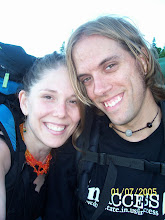Tuesday, February 26, 2008
Background on the Salem Witch Trials - Use these links to answer the questions below. http://www.salemwitchmuseum.com/
1. Approximately when did the Salem witch trials take place?
2. What are some possible causes for the hysteria in Salem?
3. Who was Samuel Parrish?
4. Who was Tituba?
5. What event concerning the Parrish children ignited the hysteria?
6. Who was Cotton Mather?
7. What types of punishment were used for those accused of witchcraft?
8. What happened to those who did not confess to witchcraft?
9. How many lives did the Salem trials ultimately claim?
Background on McCarthyism - More links, more questions. http://encarta.msn.com/
1. What did Senator Joseph McCarthy have to do with the Red Scare of the 1950’s?
2. What political situation prompted the hysteria during the Red Scare?
3. What is the HUAC and what did it set out to do in the 1940’s and 1950’s?
4. What were blacklists and who was most likely to be named to these lists?
5. What happened to those accused by Joseph McCarthy and the HUAC?
6. What kinds of trials or hearings were held? Were they fair or not?
7. What questions were accused people asked?
8. How many were found guilty? Any famous people?
9. What ultimately happened to his investigation?
1. Approximately when did the Salem witch trials take place?
2. What are some possible causes for the hysteria in Salem?
3. Who was Samuel Parrish?
4. Who was Tituba?
5. What event concerning the Parrish children ignited the hysteria?
6. Who was Cotton Mather?
7. What types of punishment were used for those accused of witchcraft?
8. What happened to those who did not confess to witchcraft?
9. How many lives did the Salem trials ultimately claim?
Background on McCarthyism - More links, more questions. http://encarta.msn.com/
1. What did Senator Joseph McCarthy have to do with the Red Scare of the 1950’s?
2. What political situation prompted the hysteria during the Red Scare?
3. What is the HUAC and what did it set out to do in the 1940’s and 1950’s?
4. What were blacklists and who was most likely to be named to these lists?
5. What happened to those accused by Joseph McCarthy and the HUAC?
6. What kinds of trials or hearings were held? Were they fair or not?
7. What questions were accused people asked?
8. How many were found guilty? Any famous people?
9. What ultimately happened to his investigation?
Tuesday, February 19, 2008
Here is the address for Ifolders:http://moodle.lakeridge.k12.in.us/ifolder/Login.aspx?ReturnUrl=%2fifolder%2fiFolders.aspx!
Type or copy it into the URL bar if the link to the right doesn't work. You can also click here.
Type or copy it into the URL bar if the link to the right doesn't work. You can also click here.
Monday, February 04, 2008
World War One Webquest
1. Research the following new weapons that were developed for use in the Great War and explain how they changed the face of war. Weapons to explore: flamethrower, tank, machine gun, submarine, airplane, and 3" mortar.
2. Explain what "no man's land" was and draw an illustration of it.
3. How was gas used as a biological weapon in the Great War? What types of gas were used, and what were their effects?
4. What was life like in the trenches for the typical German soldier?
5. We've discussed (briefly) the concept of an unreliable narrator. (Think of the multi-named protagonist from "Reconnaissance.") What are the characteristics of an unreliable narrator? How does this effect/ affect the plot of a story?
6. True or false: You should get a copy of All Quiet on the Western Front by Friday. Answer in 5 pages or less, demonstrating grade-level appropriate control of diction and tone.
7. How did Americans view the war before American involvement? Did this opinion change once the United States was involved? If so, how?
8. What happened at Verdun that made it so notorious?
Click here to start your search. You may also use such search engine sites as Google or Yahoo, or browse Wikipedia. Remember, plagarism is strictly prohibited! Use vivid sensory details in your answers, and don't be afraid to be unusual. Your anwsers are due Wednesday, so get crackin' weiners.
Daniel: Draw the following: snake, bear, square, dog.
1. Research the following new weapons that were developed for use in the Great War and explain how they changed the face of war. Weapons to explore: flamethrower, tank, machine gun, submarine, airplane, and 3" mortar.
2. Explain what "no man's land" was and draw an illustration of it.
3. How was gas used as a biological weapon in the Great War? What types of gas were used, and what were their effects?
4. What was life like in the trenches for the typical German soldier?
5. We've discussed (briefly) the concept of an unreliable narrator. (Think of the multi-named protagonist from "Reconnaissance.") What are the characteristics of an unreliable narrator? How does this effect/ affect the plot of a story?
6. True or false: You should get a copy of All Quiet on the Western Front by Friday. Answer in 5 pages or less, demonstrating grade-level appropriate control of diction and tone.
7. How did Americans view the war before American involvement? Did this opinion change once the United States was involved? If so, how?
8. What happened at Verdun that made it so notorious?
Click here to start your search. You may also use such search engine sites as Google or Yahoo, or browse Wikipedia. Remember, plagarism is strictly prohibited! Use vivid sensory details in your answers, and don't be afraid to be unusual. Your anwsers are due Wednesday, so get crackin' weiners.
Daniel: Draw the following: snake, bear, square, dog.
Subscribe to:
Posts (Atom)
